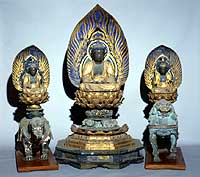
| Specified type | Prefecture designation |
|---|---|
| Type | Sculpture |
| Designated date | May 2, 1997 |
| Specified details | |
| quantity | Buddha statue (Sacred lighted statue) (one base lighted) one-piece to middle-presence Shunju sitting (one piece lighted) one-piece toward the right |
| location | Oishi City Mizusawa-ku Kuroishi Town Character Shohoji |
| owner | Shohoji |
| Holding group | |
| Management organization | |
| home page | Oshu City (Mizusawa Roman · Shohoji) |
Overview
Shoho-ji Temple is a Zen temple that was opened by Unbelievable Buddha during the north-south season as one of the bases of the Cao-dong sect in the northeastern part.
A wooden Buddha Buddha statue (Shangha Buddha in the center, toward the right, to the right, to the left, toward the left, to the left) was speculated that it was originally conceived as the main statue of the Buddha at the end of the North and South Dynasty (Myeongdeok 1392). Be done.
It is a figurative feature of this wooden Buddha statue, but quite complex forms can be seen in the expressions of clothes and hair, etc., and the author is supposed to be familiar with the form of the Buddha statue.
In addition, as for the structure, we adopted the "form of engraving and connecting two parts of the body part and connecting them", which is common with the Buddhist statues of the Ninnam period, and was the author who knew this form as an imaging method I am telling you.
This kind of situation, after the author of the statue did the study of architecture and architecture in the capital, learned the form and structure, and was related to the North Oku Bunkyo of the Shodo sect and stayed here in the first expansion period of Shohoji I am telling you.
From such a thing, it is guessed that it is the work of "Ryuzo (Ryuzo)" which is well-known for the Buddha-making activity in Shoji Temple of Shohoji and Shohoji at that time.
From the above, it is very important to think about the change of Iwate's imitation of Buddha from the north-north morning to the early days of Muromachi.
(The first tangible cultural property designation standard 2)
